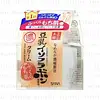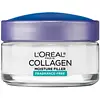What's inside
What's inside
 Key Ingredients
Key Ingredients

 Benefits
Benefits

 Concerns
Concerns

 Ingredients Side-by-side
Ingredients Side-by-side

Water
Skin ConditioningSqualane
EmollientStearic Acid
CleansingStearyl Alcohol
EmollientGlycine Max Seed Extract
Skin ConditioningButylene Glycol
HumectantTocopheryl Acetate
AntioxidantXanthan Gum
EmulsifyingMilk Ferment
Skin ConditioningCarbomer
Emulsion StabilisingSodium Hydroxide
BufferingAlcohol Denat.
AntimicrobialPalmitic Acid
EmollientCetearyl Alcohol
EmollientAluminum Starch Octenylsuccinate
AbsorbentGlycerin
HumectantCitric Acid
BufferingCyclohexasiloxane
EmollientBeeswax
Emulsion StabilisingMethylparaben
PreservativeGlyceryl Stearate
EmollientCyclopentasiloxane
EmollientWater, Squalane, Stearic Acid, Stearyl Alcohol, Glycine Max Seed Extract, Butylene Glycol, Tocopheryl Acetate, Xanthan Gum, Milk Ferment, Carbomer, Sodium Hydroxide, Alcohol Denat., Palmitic Acid, Cetearyl Alcohol, Aluminum Starch Octenylsuccinate, Glycerin, Citric Acid, Cyclohexasiloxane, Beeswax, Methylparaben, Glyceryl Stearate, Cyclopentasiloxane
Water
Skin ConditioningCyclohexasiloxane
EmollientGlycerin
HumectantButyrospermum Parkii Butter
Skin ConditioningIsohexadecane
EmollientPentaerythrityl Tetraethylhexanoate
EmollientDipropylene Glycol
HumectantCera Alba
EmollientStearic Acid
CleansingPalmitic Acid
EmollientCyclopentasiloxane
EmollientAcrylamide/Sodium Acryloyldimethyltaurate Copolymer
Emulsion StabilisingPEG-100 Stearate
Stearyl Alcohol
EmollientGlyceryl Stearate
EmollientPEG-20 Stearate
EmulsifyingBoswellia Serrata Extract
Skin ConditioningManganese Gluconate
Skin ConditioningSoluble Collagen
HumectantAtelocollagen
Skin ConditioningDimethiconol
EmollientPolysorbate 80
EmulsifyingPentaerythrityl Tetraisostearate
EmollientTocopherol
AntioxidantDisodium EDTA
Sodium Hydroxide
BufferingSilica Dimethyl Silylate
EmollientSodium Chondroitin Sulfate
Skin ConditioningPhenoxyethanol
PreservativeMethylparaben
PreservativeImidazolidinyl Urea
PreservativePotassium Sorbate
PreservativeParfum
MaskingAlpha-Isomethyl Ionone
PerfumingButylphenyl Methylpropional
PerfumingBenzyl Salicylate
PerfumingLinalool
PerfumingHexyl Cinnamal
PerfumingHydroxyisohexyl 3-Cyclohexene Carboxaldehyde
MaskingCitronellol
PerfumingWater, Cyclohexasiloxane, Glycerin, Butyrospermum Parkii Butter, Isohexadecane, Pentaerythrityl Tetraethylhexanoate, Dipropylene Glycol, Cera Alba, Stearic Acid, Palmitic Acid, Cyclopentasiloxane, Acrylamide/Sodium Acryloyldimethyltaurate Copolymer, PEG-100 Stearate, Stearyl Alcohol, Glyceryl Stearate, PEG-20 Stearate, Boswellia Serrata Extract, Manganese Gluconate, Soluble Collagen, Atelocollagen, Dimethiconol, Polysorbate 80, Pentaerythrityl Tetraisostearate, Tocopherol, Disodium EDTA, Sodium Hydroxide, Silica Dimethyl Silylate, Sodium Chondroitin Sulfate, Phenoxyethanol, Methylparaben, Imidazolidinyl Urea, Potassium Sorbate, Parfum, Alpha-Isomethyl Ionone, Butylphenyl Methylpropional, Benzyl Salicylate, Linalool, Hexyl Cinnamal, Hydroxyisohexyl 3-Cyclohexene Carboxaldehyde, Citronellol
 Reviews
Reviews

Ingredients Explained
These ingredients are found in both products.
Ingredients higher up in an ingredient list are typically present in a larger amount.
Cyclohexasiloxane is a type of silicone more commonly known as D6. It is an emollient and solvent.
Cyclohexasiloxane is used to evenly distribute ingredients throughout the product. When applied to the skin, Cyclohexasiloxane evaporates and leaves behind a silky feel.
As an emollient, it can help the skin feel soft and hydrated. It is also used to reduce frizz in hair products.
Learn more about CyclohexasiloxaneCyclopentasiloxane, or D5, is a silicone used to improve texture of products and trap moisture.
D5 is considered lightweight and volatile. Volatile means it evaporates quickly after application. Once evaporated, D5 leaves a thin barrier that helps keep skin hydrated.
It is also an emollient. Emollients help soften the skin and prevent water loss. Silicones create a silky texture in products. D5 helps other ingredients become more spreadable.
Studies show D5 is safe to use in skincare products. We recommend speaking with a skincare professional if you have concerns.
Learn more about CyclopentasiloxaneGlycerin is already naturally found in your skin. It helps moisturize and protect your skin.
A study from 2016 found glycerin to be more effective as a humectant than AHAs and hyaluronic acid.
As a humectant, it helps the skin stay hydrated by pulling moisture to your skin. The low molecular weight of glycerin allows it to pull moisture into the deeper layers of your skin.
Hydrated skin improves your skin barrier; Your skin barrier helps protect against irritants and bacteria.
Glycerin has also been found to have antimicrobial and antiviral properties. Due to these properties, glycerin is often used in wound and burn treatments.
In cosmetics, glycerin is usually derived from plants such as soybean or palm. However, it can also be sourced from animals, such as tallow or animal fat.
This ingredient is organic, colorless, odorless, and non-toxic.
Glycerin is the name for this ingredient in American English. British English uses Glycerol/Glycerine.
Learn more about GlycerinGlyceryl Stearate is a mix of glycerin and stearic acid.
It is used to stabilize the mixing of water and oil ingredients. By preventing these ingredients from separating, it can help elongate shelf life. It can also help thicken the product's texture.
As an emollient, it helps soften skin and supports barrier-replenishing ingredients.
In cosmetics, Glyceryl Stearate is often made from vegetable oils or synthetically produced.
This ingredient may not be fungal-acne safe
Fun fact: The human body also creates Glyceryl Stearate naturally.
Learn more about Glyceryl StearateMethylparaben is a preservative and is a paraben. It is used to prevent the growth of fungus, mold, and other harmful bacteria. Parabens are chemicals used as preservatives in both cosmetics and food.
Methylparaben can be synthetically created. It can also be found naturally in some fruits, such as blueberries.
Oftentimes, Methylparaben is combined with other parabens to help increase the shelf life.
The safety of Methylparaben is currently being studied. While ongoing studies are looking into the safety of parabens, the results have been very mixed. Some studies have not found Methylparaben to be harmful.
Learn more about MethylparabenPalmitic Acid is a fatty acid naturally found in our skin and in many plant and animal sources. In cosmetics, it is usually derived from palm oil. It serves many purposes in skincare, acting as a cleanser, emollient, and emulsifier.
As an emollient, palmitic acid helps soften and smooth the skin by preventing water loss. In cleansers, it helps remove oil and dirt while creating foam.
Its emulsifying properties help stabilize products by keeping water and oil-based ingredients from separating.
This may not be suitable for fungal acne-prone skin, as fatty acids like this can sometimes trigger breakouts in sensitive individuals.
Learn more about Palmitic AcidSodium Hydroxide is also known as lye or caustic soda. It is used to adjust the pH of products; many ingredients require a specific pH to be effective.
In small amounts, sodium hydroxide is considered safe to use. However, large amounts may cause chemical burns due to its high alkaline.
Your skin has a natural pH and acid mantle. This acid mantle helps prevent harmful bacteria from breaking through. The acid mantle also helps keep your skin hydrated.
"Alkaline" refers to a high pH level. A low pH level would be considered acidic.
Learn more about Sodium HydroxideStearic Acid is a fatty acid. It is an emollient, emulsifier, and texture enhancer.
As an emollient, stearic acid helps soften skin. It aids the skin's protective barrier by preventing water loss. It also provides a gentle cleansing effect without stripping away natural oils.
Stearic acid may also be used to enhance the texture of products. It can add volume and stabilize ingredients such as water and oil. This can help water and oil ingredients from separating.
Sources of stearic acid include animal or vegetable fats/oils such as coconut or shea. It can be naturally found in butter, cocoa butter, shea butter, vegetable fats, and animal tallow.
This ingredient may not be Malassezia folliculitis, or fungal-acne safe.
Learn more about Stearic AcidStearyl Alcohol is a type of fatty alcohol from stearic acid. It is a white, waxy compound used to emulsify ingredients.
Fatty Alcohols are most often used as an emollient or to thicken a product. Emollients help soothe and hydrate the skin by trapping moisture.
They are usually derived from natural fats and oils and therefore do not have the same drying or irritating effect as solvent alcohols. FDA allows products labeled "alcohol-free" to have fatty alcohols.
Learn more about Stearyl AlcoholWater. It's the most common cosmetic ingredient of all. You'll usually see it at the top of ingredient lists, meaning that it makes up the largest part of the product.
So why is it so popular? Water most often acts as a solvent - this means that it helps dissolve other ingredients into the formulation.
You'll also recognize water as that liquid we all need to stay alive. If you see this, drink a glass of water. Stay hydrated!
Learn more about Water